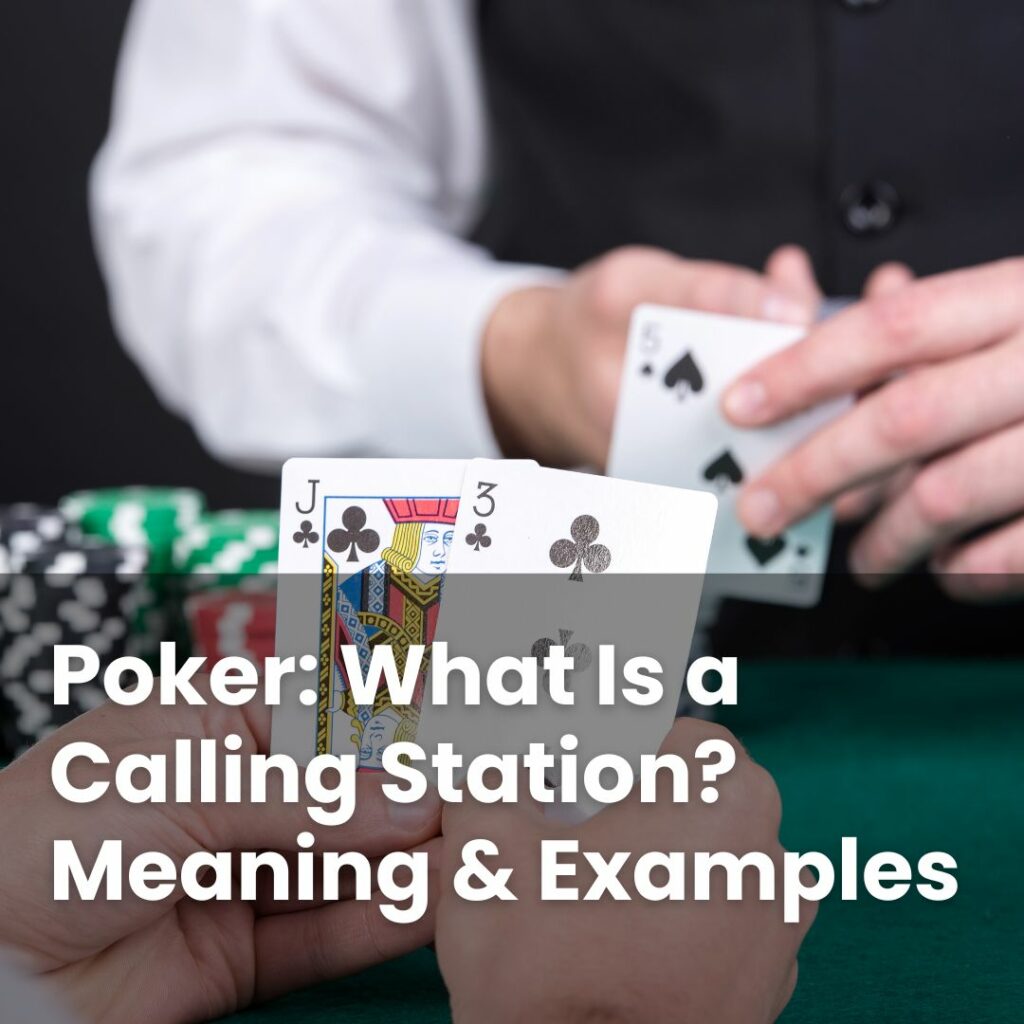In every poker game, patterns emerge in how people choose to play. Some take a sharp approach, others fold more often, and some seem simply unwilling to let go of a hand. Among the various playing styles you might come across, one in particular stands out for how often they just call.
This blog post explores that distinctive style and shows how to identify it at the table, understand the thinking behind it, and adjust your strategy when you spot it. We’ll also look at real-hand examples to bring these concepts to life and explain how this style fits into the wider poker landscape.
Whether you’re just starting out or brushing up, this is a practical walkthrough for anyone trying to make sense of what they’re seeing at the table.
Read on to learn more.
What Does Calling Station Mean in Poker?
You may have heard players refer to someone who “never folds” or “just calls everything.” These players stick around in hands that many others would exit. Rather than changing gears or stepping away from uncertain situations, they lean heavily into matching bets.
In poker terms, a calling station is someone who tends to call far more often than they fold or raise. They stay in hands longer than most, regardless of what cards they’re holding, often following the hand all the way to showdown.
At first glance, this can look like persistence or optimism. But when this tendency shows up over and over again in situations where other actions would usually be more effective, it starts to form a recognisable pattern. And that’s what players are referring to when they use the label.
So, how can you move beyond a hunch and spot one clearly?
How to Recognise a Calling Station at the Table
The key is not to rely on one odd hand, but to watch a few orbits and notice the trends. Calling stations often show up by taking part in too many hands before the flop—especially with cards that don’t connect well or are weak in value. Then, even if the flop doesn’t help them much, they keep calling.
They don’t tend to push the action. Big raises are uncommon, and even when they have something decent, they often prefer to just call. One interesting clue is their response to different bet sizes: small or large, they treat them much the same and continue to call on the turn and river.
You’ll also see a kind of quiet determination. If someone consistently calls on the flop, turn, and river—even when the board clearly turns against them—they’re showing the kind of repeated behaviour that defines this style.
These surface signals point to a deeper set of tendencies and decisions. To read them better, it helps to understand the patterns that lie beneath.
See Our Top-Rated Online Casinos
Find the best online casino bonuses, read reviews from real players & discover brand new casinos with our list of recommended sites
Common Traits of Poker Calling Station Players
Underneath the surface, calling stations tend to shy away from being the one driving the action. Instead, they focus more on staying involved. This can mean limping or calling pre-flop instead of raising, then following through with calls on later streets even when their hand isn’t strong, such as a bottom pair, a weak top pair, or an incomplete draw.
They might justify their calls with vague suspicions, like thinking an opponent might not really have it. Often, the decision to call isn’t about the numbers or the board, but about a reluctance to walk away. You’ll also notice that these players give less weight to things like position or how the board interacts with typical ranges.
Interestingly, they become much more readable when they do take aggressive action. A raise from a calling station tends to mean something. Because they so rarely do it, that change in pace is usually tied to a much stronger hand. Spotting that contrast is a useful edge.
To truly understand why these choices happen again and again, it helps to look at the thinking behind them.
Why Do Some Players Become Calling Stations?
This style often develops from uncertainty. Many newer players don’t yet feel sure about when to step back or when to apply pressure. In that situation, calling feels like the middle ground. It keeps them in the hand, and it delays the need to make a firmer decision.
There’s also a strong psychological element. No one wants to fold a winning hand. Even though it doesn’t happen often, the memory of that one time it did can stick around. That emotional weight leads some to call “just in case.” Some are curious to see what comes next. Others feel they’ve already committed chips and don’t want to let them go.
Certain concepts are also misread. Players may call thinking they’re getting a good price, even when they’re not. Or they might not fully grasp how being out of position or facing stronger ranges affects their chances.
Whatever the mix of reasons, this is a stage many pass through while learning. With more experience, and a few clear adjustments, players can shift away from this style and towards more measured decision-making.
Examples of Calling Station Play in Real Hands
Imagine a player who sees a flop after calling pre-flop with nine-seven off-suit. The board comes ace, ten, two with no help to their hand. They still call a continuation bet. A low turn card changes little, and they call again. On the river, the board is threatening, but they call one more time with nine-high. It’s not about one poor decision—it’s about the pattern of staying in with no plan.
In another hand, someone calls a raise with pocket twos, facing an early position opponent. The board runs out with high, connected cards that clearly favour the raiser. Still, they continue calling until the showdown, showing a hand that never had much chance. The focus wasn’t on how likely they were to be ahead, but rather on a hope that something might change.
Or take a hand where a player calls a large flop bet chasing a flush with only one suited card in hand. The turn is no help. Still, they call again. Even when the river finally helps sometimes, the amount spent chasing it usually outweighs the occasional win.
These kinds of examples build the picture. The next step is learning how to use that picture at the table.
How to Adjust When Facing a Calling Station
If you find yourself up against a player who calls far more often than they fold or raise, a clear and steady approach can make a real difference. When you’re holding strong hands—such as top pair with a solid kicker, two pair, or reliable made draws—it often makes sense to bet for value. You might even consider leaning towards larger bet sizes, as this type of player is likely to continue calling even when holding weaker hands.
Bluffing, on the other hand, becomes less effective. If your opponent rarely folds, then trying to push them off a hand may not work as well as it would against others. That doesn’t mean giving up on semi-bluffing entirely—but if you choose to take that route, it helps to do so with hands that have multiple ways to improve, rather than relying on your opponent backing down.
There’s no real need to overcomplicate things. If someone is willing to call often, slowplaying strong hands can just give them more chances to catch up. In those spots, many players prefer to charge for continued interest. That said, if you’re the one holding a medium-strength hand on a difficult board, it might be better to keep the pot smaller and approach later streets with caution, especially if you’re facing pressure.
Position also plays an important role. If you isolate this type of player when you’re acting last, it often leads to simpler, more controlled decisions. You can choose the pace of the hand and spot opportunities more easily. And if someone who usually only calls suddenly decides to raise, it’s worth paying close attention—that shift in behaviour often reflects something stronger than usual.
Above all, it helps to stay measured in your own decisions. If you’re playing within clear boundaries and taking breaks when needed, you’ll likely find it easier to respond calmly and effectively. Against a style built around frequent calls, that kind of clarity tends to go a long way.
Is Being a Calling Station a Bad Thing?
If you find yourself calling more often than folding or raising, it’s not necessarily a sign that you’re doing something wrong—but over time, this approach can start to show its limits. When you call too widely, you may end up putting chips in with hands that don’t hold up well against the kinds of ranges you’re likely to face, especially as the hand progresses.
That said, it’s a stage many players go through, particularly when starting out. If you’re in that phase now, you’re not alone—and it often leads to useful insights. You might begin to see how position shapes decisions, how certain board textures can favour different ranges, and which hands are more likely to stand up by showdown.
If you choose to refine your approach, you don’t need to overhaul everything at once. Small changes often have a noticeable effect. You could start by tightening your pre-flop selections, folding more often on later streets when the signs point clearly in one direction, and taking a moment to consider why your opponent might be betting—not just what you’re holding.



